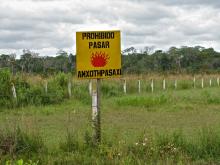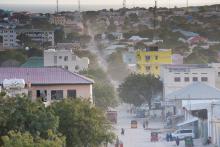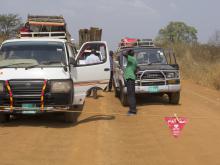Basic international humanitarian law (IHL) rules applicable to this situation:
Parties to the conflict must distinguish between civilians and combatants, and between civilian objects and military objects. Attacks may only be directed against combatants or military objectives (principle of distinction).
It is prohibited to launch indiscriminate attacks as well as attacks which may be expected to cause incidental loss of civilian life, injury to civilians, damage to civilian objects, or a combination thereof, which would be excessive in relation to the concrete and direct military advantage anticipated (principle of proportionality).
In conducting military operations, constant care must be taken to spare the civilian population, civilians and civilian objects. All feasible precautions must be taken to avoid, and in any event to minimize, incidental loss of civilian life, injury to civilians and damage to civilian objects including when choosing means and methods of warfare (principle of precautions in attack).
The case in brief
The African Union Mission in Somalia (AMISOM) was created by the African Union’s Peace and Security Council in 2007 as a peacekeeping mission with a mandate to support national reconciliation efforts in Somalia. Subsequently the mission faced allegations that it was responsible for civilian casualties. On 31 July 2015, an incident involving AMISOM troops led to the death of seven civilians.
Prompted by the legal obligation to protect civilians and conscious that the success of its mission depended on earning the trust of the Somali population, AMISOM took concrete steps to protect civilians from the effects of hostilities.
IHL compliance highlights
- Facing allegations that it was responsible for civilian casualties, AMISOM sought expert help to revise its Indirect Fire Policy aimed at taking all feasible precautions to avoid incidental harm to civilians.
- Acting on expert recommendations, AMISOM established a Civilian Casualty Tracking Analysis and Response Cell (CCTARC) to record and analyse reported incidents of civilian harm caused by AMISOM operations. Besides strengthening accountability, the information gathered is factored into the planning of subsequent AMISOM operations to better protect civilians in future. The CCTARC was incorporated into AMISOM’s mandate in 2012.
- Following the fatal incident in July 2015, the CCTARC led the investigation of the incident, prompting an inquiry that resulted in the indictment of three AMISOM personnel and a public acknowledgement of responsibility from the AMISOM leadership.
Case prepared by Francesca Romana Ferrone, Joseph Gitata and Ana-Paula Ilg, LL.M. students at Roma Tre University under the supervision of Giulio Bartolini (IHL Professor), Tommaso Natoli (Research assistant), Alice Riccardi (Research assistant) and Laura Di Gianfrancesco (PhD student), Roma Tre University IHL Legal Clinic.
A. STATEMENT BY THE AFRICAN UNION SPECIAL REPRESENTATIVE FOR SOMALIA AND HEAD OF AMISOM ADDRESSING THE 31ST JULY 2015 INCIDENT IN MARKA
[Source: AMISOM, “Statement by the African Union Special Representative for Somalia and Head of AMISOM addressing the 31st July 2015 Incident in Marka, Lower Shabelle Region of Somalia”, 21 August 2015, available at https://reliefweb.int/report/somalia/statement-african-union-special-representative-somalia-and-head-amisom-addressing]
“ […]
This afternoon I would like to talk to you about the incident involving AMISOM troops in Marka on 31st July 2015.
You would recall that we issued a statement on the 4th of August in which we stated that the officer in charge of the troop detachment was recalled for questioning as a prelude to a possible further investigation.
Indeed, we have established that, on that occasion, seven civilians died following an incident involving our troops.
At this juncture therefore, I would like on behalf of the African Union, to offer my sincere apology for these deaths.
We regret these deaths.
[…]
Since we established that there was a credible (prima facie) basis for a further and thorough investigation of the allegations, we instituted a process of investigations to establish further facts into the circumstances that led to this tragic incident.
[…] In addition, and it is in that regard that three AMISOM personnel have been indicted and are awaiting to be arraigned before a military judicial process.
I would like to commend the commanders for taking appropriate and responsive action in dealing with this matter in line with the Mission’s conduct and discipline procedures.
[…] Let me reiterate here that as the Head of AMISOM, together with my colleagues seated with me here, I will continue to ensure that all AMISOM personnel, whether uniformed or civilians, armed or unarmed, strictly adhere to the fundamental principles of International Humanitarian Law as well as the African Union Peace Support Operations Code of Conduct.
[…]
B. AMISOM’S ACTIONS FOLLOWING REPORTED CIVILIAN CASUALTIES
[Source: Human Rights Council, Report of the independent expert on the situation of human rights in Somalia, Bahame Tom Nyanduga, 28 October 2015, available at https://digitallibrary.un.org/record/811603?ln=en]
[…]
19. The Independent Expert expressed his concerns over these incidents to the SRCC [Special Representative of the African Union Commission Chairperson] and Head of AMISOM and urged AMISOM to conduct investigations into the incidents and hold those found responsible accountable for their actions.
20. In response, the SRCC informed the Independent Expert of the activities undertaken by AMISOM prior to commencing the operation in order to ensure compliance with the international humanitarian law. These included, inter alia: Issuance of a Directive Operational Commanders in which he detailed applicable international humanitarian law provisions, AMISOM rules of engagement, provisions of the AMISOM standard operating procedures on the treatment of detainees; Review of Operations Eagle and Indian Ocean by the operational commanders with specific reference to lessons learned. […]
21. With respect to the 31 July 2015 incident, the SRCC reported that following his instructions, the contingent concerned conducted its own investigations and submitted a report to the SRCC on 19 August 2015. […]. The SRCC subsequently convened a Board of Inquiry composed of members from AMISOM military, police and civilian components to investigate the overall circumstances of the incidents […].
On 21 August 2015, the SRCC held a press conference in which he announced actions taken to address the 31 July incident. The SRCC also informed the Independent Expert that AMISOM had put in place a civilian casualty tracking cell.
C. AMISON’S CIVILIAN CASUALTY TRACKING ANALYSIS AND RESPONSE CELL
[Source: AMISOM, Civilian Casualty Tracking, Analysis, and Response Cell (CCTARC), available at https://amisom-au.org/cctarc/]
[…] CCTARC [Civilian Casualty Tracking Analysis And Response Cell] was established under the authority of the African Union Peace and Security Council, pursuant to the express mandate set out in United Nations Security Council Resolution (UNSCR) 2036 (2012), UNSCR 2093 (2013), UNSCR 2124 (2013), UNSCR 2182 (2014) and UNSCR 2232 (2015).
The CCTARC is owned and controlled exclusively by AMISOM.
Incidents involving AMISOM and resulting in civilian casualties would have a strategic impact on AMISOM mission in Somalia. CCTARC captures and record reported events and incidents of civilian casualties within AMISOM area of operation through a comprehensive electronic database. In a joint efforts with its partners CCTARC aim to protect the Somali population by applying preventative measures to reduce the incidents of civilian casualties and to help Federal Government of Somalia to restore peace, security and stability in the country.
D. THE IMPLEMENTATION OF THE CIVILIAN CASUALTY TRACKING ANALYSIS AND RESPONSE CELL
[Source: Natasja Rupesinghe, “The Civilian Casualty Tracking Analysis and Response Cell in the African Union Mission in Somalia. An emerging best practice for AU peace support operations?”, Norwegian Institute of International Affairs, Policy Brief 3, 2019, available at https://nupi.brage.unit.no/nupi-xmlui/bitstream/handle/11250/2582457/NUPI_Policy_Brief_3_2019_Rupesinghe.pdf?sequence=2&isAllowed=y]
In 2012, a Civilian Casualty Tracking, Analysis and Response Cell (CCTARC) was incorporated into the African Union Mission in Somalia’s (AMISOM) mandate through the United Nations Security Council Resolution 2036 (2012) and subsequently 2093 (2013). Civilian Casualty Tracking is defined as a process through which ‘a military or peacekeeping operation gathers data on civilian harm caused by its operations and then uses that data to improve operations and properly respond to civilian losses’.
[…]
The CCTARC was included in AMISOM’s mandate in response to rising allegations that blamed the mission for causing civilian casualties. To remedy this, AMISOM invited a team of experts from the Centre for Civilians in Conflict, Bancroft Global and British General Roger Lane (a former ISAF Commander from Afghanistan) in February 2011 to help revise the mission’s Indirect Fire Policy (IDF). One of the main recommendations of the IDF was to establish a CCTARC, which was subsequently incorporated into AMISOM’s mandate in 2012.
[…]
The CCTARC’s mandate has three core pillars. First, it tracks, and analyses civilian harm caused by AMISOM operations. To maintain focus on AMISOM-related harm in a context of limited resources, it does not track harm caused to civilians by other actors in Somalia. Second, the CCTARC is designed to feed this data into the planning of future operations, to adapt tactical/operational policies and procedures, and to inform pre-deployment and in-mission training. The aim of this cyclical feedback mechanism is to prevent and reduce harm to civilians, and to enhance the mission’s overall effectiveness. Finally, the CCTARC should advise when the mission should make “ex-gratia payments”. AMISOM defines “ex-gratia payments” as providing “recognition and assistance to civilians they harm within the lawful parameters of combat operations, despite having no legal obligation to do so.”. These can be apologies, monetary payments, in-kind assistance, or other symbolic or material gestures. In a context like Somalia, this is vital and deemed culturally appropriate, since the payment of collective “blood money”, or “Diya” is an important customary practice.
[…]
The CCTARC started tracking AMISOM-related harm to civilians including civilian casualties (injury and death), incidents of SEA [Sexual Exploitation and Abuse] and damage to property (including livestock) in June 2015. […]
Initially the cell relied on open-source information from social media, but gradually started drawing information from other sources such as situation reports by Sector Commanders, information from Civil-Military Coordination Officers and AMISOM police patrol reports. Staff also use external sources including from the Somali police, social media, local newspapers, and the UNDSS [United Nations Department for Safety and Security] Daily Security Situation reports. Some information is channelled through the Senior Leadership Forum between the United Nations Mission in Somalia (UNSOM) and AMISOM or through the UNSOM Human Rights Division. Individuals can also make claims directly via telephone, the AMISOM website, or in person.
Once an allegation is made, staff conduct an initial assessment to determine the veracity of the claim, by triangulating evidence. They then submit a report containing their assessment to the head of the Human Rights and Protection for further action. In cases of ‘serious’ allegations, including a civilian injury or death, major damage or loss, the case is submitted to the Board of Inquiry for further investigation. The Board of Inquiry, also situated in the Protection cluster is a separate entity from the CCTARC, responsible for conducting investigations into third-party claim allegations against AMISOM. The Special Representative of the African Union Commission Chairperson for Somalia (SRCC) appoints AMISOM personnel (usually four persons) to partake in the Boards of Inquiry, which can be convened for different reasons, and at different levels (contingent or headquarters) on an ad-hoc basis. Notable examples include the incident in the town of Marka (Lower Shabelle region) on 31 July 2015, which led to the AMISOM leadership publicly acknowledging that AU forces were responsible for killing seven civilians, and the subsequent indictment of three AMISOM personnel.
[…]
Discussion
I. Classification of the Conflict and Applicable Law
1. How would you classify the situation in Somalia? Was there an armed conflict? If yes, who were the parties to the conflict? What additional information would you require in order to make such a determination? Is AMISOM bound by IHL? (GC I-IV, Art. 3; P II, Art. 1)
II. Protection of Civilians in Armed Conflict
2. How does IHL protect the civilian population from the effects of hostilities? How are the principles of distinction, proportionality and precautions construed under IHL? (PI, Arts 35, 43, 48, 50, 51, 52, 57, 58; PII, Art.13; CIHL Rules 1, 7, 11, 14, 15, 17;)
3. Is there an obligation under IHL to document civilian harm resulting from attacks launched by the parties to the conflict? Are the parties to the conflict expected to assess whether there will be civilian casualties prior to launching an attack? After an attack is carried out? (PI, Arts 51, 57; PII, Art. 13; CIHL, Rules 1, 14, 15)
4. Are attacks only lawful if they do not result in death and injury of the civilian population? Does the fact that civilian deaths and destruction of civilian property occur mean that IHL is violated? Does IHL obligate a party to avoid civilian casualties at all costs? What guidance, if any, does IHL provide on weighing military objectives against anticipated civilian casualties? (PI, Arts 51, 57; CIHL, Rules 11, 14, 15)
5. Does IHL oblige the parties to the conflict to make sure that its military personnel are familiar with the rules of IHL? Is there a duty under IHL to identify trends of civilian casualties from past operations and to integrate the findings in the future training programs? (P I, Art. 83, 87; P II, Art. 19; CIHL, Rule 142)
III. Elements Contributing to Respect for IHL
6. (Document A) What is the relevance of formal apologies to the victims’ families and the community? In your opinion, why did the Head of AMISOM apologize to the Federal Government of Somalia as well? Can public opinion influence the parties to the conflict to act in accordance with the law?
7. (Document B) Do you think the after-action review and identification of lessons learned from recent events can influence further protection of civilian population?
8. (Document C) What do you think AMISOM means by “incidents involving AMISOM and resulting in civilian casualties would have a strategic impact on AMISOM mission in Somalia”? Can the respect for the law and protection of civilians be in favor of armed forces’ military interest?
9. (Document C) What is the importance of pre-deployment training? Can it be considered as a measure of ensuring prevention of civilian casualties? What might be the contribution of non-state entities, as training centers and NGOs, in providing tailored measures in this area? Can you mention some relevant training and dissemination center in the area of IHL? What is their role in the discipline?
10. (Documents A and C) How might the measures taken in the case at stake impact the civilians’ perception of AMISOM? Could these measures have the strategic impact of favoring the implementation of the mandate and maintaining support and trust from local actors and state authorities?
11. (Documents C and D) What factors, in your opinion, contributed to the adoption of CCTARC by AMISOM? The UN Security Council authorization? How can external pressure from internal and international actors, such as NGOs and the civil society, induce compliance with IHL?






